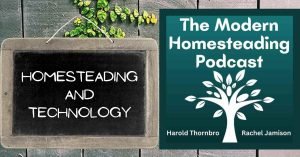Getting the most from your garden depends on a lot of things including the right climate conditions for each specific plant. On today’s podcast episode I discuss how to locate or create microclimates for your garden and how best to use those microclimates.
Homestead Updates:
- Why I haven’t been podcasting and responding to social media and emails much lately.
- Planting fall crops
- This year’s tomato crop
Homesteading Relevant News:
Hangin’ Out on the Homestead Front Porch
A new segment where I share a few things from the Homestead Front Porch Facebook group including a question I ask group members and some of their answers.
What is something you know about homesteading now that you wish you had known when you started?
Main Topic Of Discussion:
Creating and Utilizing Microclimates
What is a microclimate?
Simply put it is the climate of a very small or restricted area, especially when this differs from the climate of the surrounding area. Microclimates can allow the growing of plants in an area that normally would not grow in the hardiness zone or the season of the area.
Microclimates are created and vary due to soil, water, weather, sun, and warmth. Variances in these areas can be caused by many reasons including garden direction, exposure to wind, slopes, and berms, structures and overhangs, the topography of the land, and soil drainage along with many other factors.
Locating microclimates on your property.
University of California Division of Agriculture and Natural Resources has a great Garden Site Microclimate Evaluation Form that can be downloaded or printed off to help locate microclimates on your homestead.
Creating microclimates.
To create a microclimate you simply need to mimic what causes microclimates naturally. This can be done by adding things like trees, boulders, ponds, and berms. I discuss some of the ways I have done this on my homestead on the podcast.
Utilizing microclimates.
Identify what plants you want to grow and what those plants like then find or create the microclimate that best fits that plant. As an example of what gardening this way can do, creating microclimates has enabled me to grow leaf lettuce throughout the summer without it bolting too quickly.
Today’s Recommendations:



